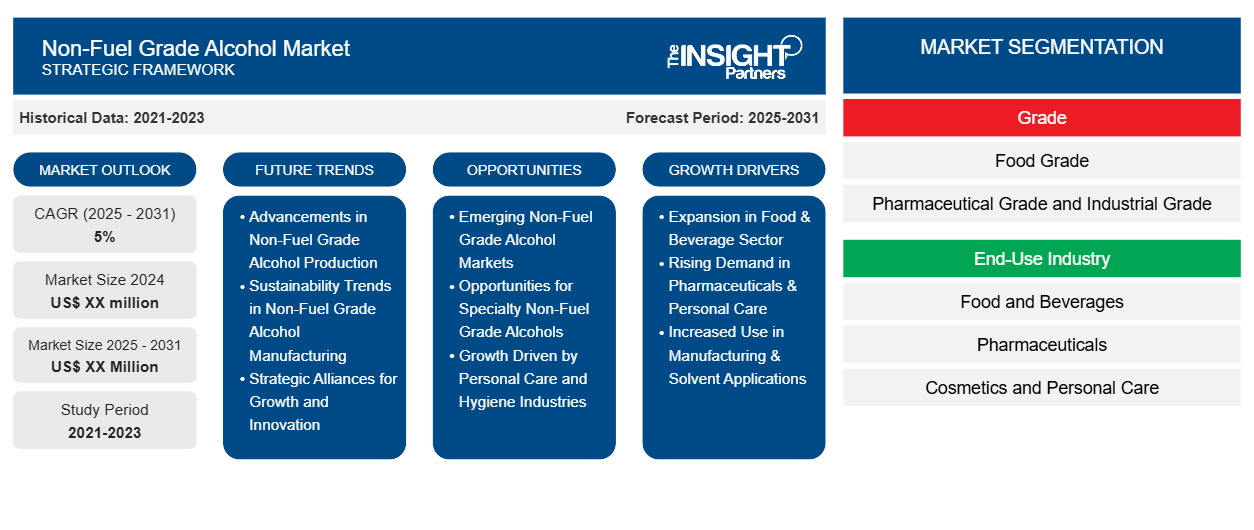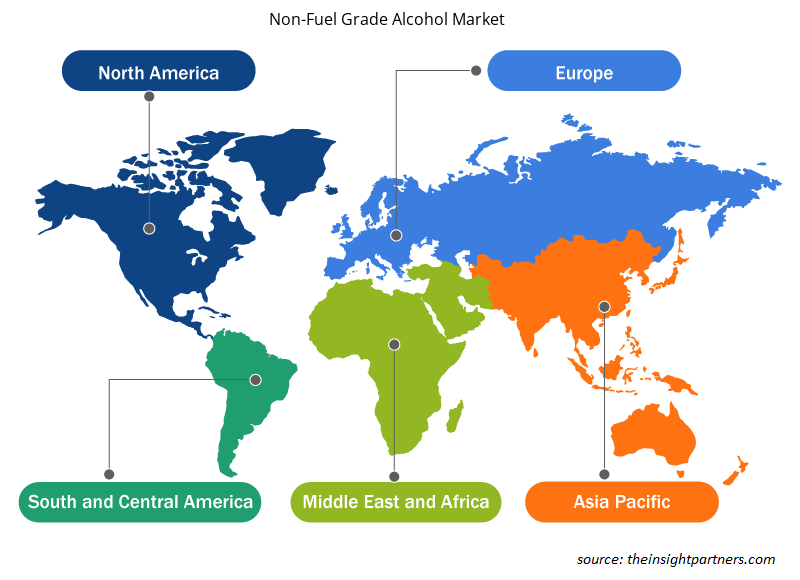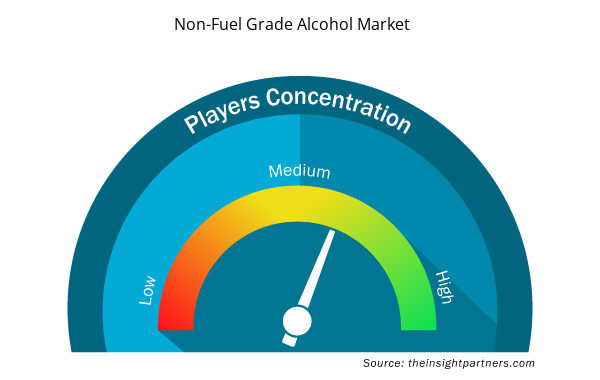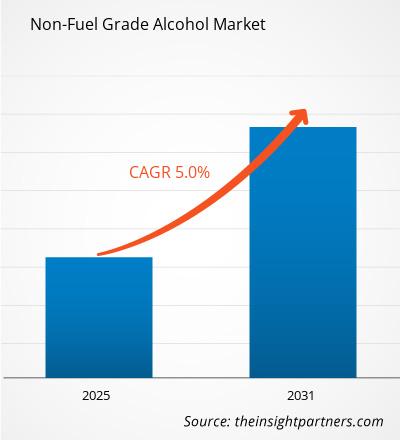Si prevede che il mercato dell'alcol non combustibile registrerà un CAGR del 5% dal 2025 al 2031, con una dimensione di mercato in espansione da XX milioni di dollari USA nel 2024 a XX milioni di dollari USA entro il 2031.
Il report è segmentato per grado (grado alimentare, grado farmaceutico e grado industriale). Il report presenta inoltre analisi basate sul settore di utilizzo finale (cibo e bevande, prodotti farmaceutici, cosmetici e cura della persona, prodotti chimici e altri). L'analisi globale è ulteriormente suddivisa a livello regionale e nei principali paesi. Le dimensioni del mercato e le previsioni a livello globale, regionale e nazionale per tutti i segmenti di mercato chiave sono coperte nell'ambito. Il report offre il valore in USD per l'analisi e i segmenti di cui sopra. Il report fornisce statistiche chiave sullo stato di mercato dei principali attori del mercato e offre tendenze e opportunità di mercato.
Scopo del rapporto
Il report Non-Fuel Grade Alcohol Market di The Insight Partners mira a descrivere il panorama attuale e la crescita futura, i principali fattori trainanti, le sfide e le opportunità. Ciò fornirà spunti a vari stakeholder aziendali, come:
- Fornitori/produttori di tecnologia: per comprendere le dinamiche di mercato in evoluzione e conoscere le potenziali opportunità di crescita, consentendo loro di prendere decisioni strategiche informate.
- Investitori: condurre un'analisi completa delle tendenze relative al tasso di crescita del mercato, alle proiezioni finanziarie del mercato e alle opportunità esistenti lungo la catena del valore.
- Enti di regolamentazione: regolamentano le politiche e le attività di controllo sul mercato allo scopo di ridurre al minimo gli abusi, preservare la fiducia degli investitori e sostenere l'integrità e la stabilità del mercato.
Segmentazione del mercato dell'alcol non combustibile
Grado
- Grado alimentare
- Grado farmaceutico e grado industriale
Settore di utilizzo finale
- Cibo e bevande
- Prodotti farmaceutici
- Cosmetici e cura della persona
- Prodotti chimici e altri
Personalizza questo report in base alle tue esigenze
Riceverai la personalizzazione gratuita di qualsiasi report, comprese parti di questo report, o analisi a livello nazionale, pacchetto dati Excel, oltre a usufruire di grandi offerte e sconti per start-up e università
Mercato dell'alcol non combustibile: approfondimenti strategici

- Scopri le principali tendenze di mercato in questo rapporto.Questo campione GRATUITO includerà analisi di dati che spaziano dalle tendenze di mercato alle stime e alle previsioni.
Fattori trainanti della crescita del mercato dell'alcol non combustibile
- Espansione nel settore alimentare e delle bevande: il crescente utilizzo di alcol nel settore alimentare e delle bevande continua a essere uno dei fattori significativi che alimentano la crescita del mercato dell'alcol non di grado combustibile. L'etanolo è un alcol non di grado combustibile essenziale ampiamente utilizzato nella lavorazione alimentare come conservante, agente aromatizzante e solvente. Il know-how delle bevande artigianali e la disponibilità di bevande pronte da bere (RTD) premium, spesso miscelate con alcol e liquori aromatizzati alcolici, aumentano la domanda di alcol non di grado combustibile di elevati standard.RTD)-often blended in alcohol and spirituous flavored liquors-increasing demand for non-fuel grade alcohol of high standards.
- Domanda crescente nei prodotti farmaceutici e per la cura della persona: un'altra categoria di alcoli non combustibili in cui l'etanolo e l'alcool isopropilico hanno la maggior parte delle applicazioni è quella dei prodotti farmaceutici e per la cura della persona. Gli alcoli si trovano in sfregamenti, solventi e anche per la disinfezione. Il mercato globale delle materie prime è stato modificato dall'adozione di misure sanitarie per garantire la sicurezza a causa di malattie pandemiche come il COVID-19, poiché le persone mantengono sani standard di pulizia, aumentando il consumo di disinfettanti e igienizzanti. Questa tendenza probabilmente persisterà, tenendo conto della considerazione degli alcoli non combustibili nell'uso industriale, creando una maggiore domanda.
- Maggiore utilizzo in applicazioni di produzione e solventi: i solventi alcolici non di grado combustibile sono essenziali in tutte le strutture, compresi rivestimenti, adesivi o persino detergenti. Con la crescita del segmento manifatturiero nei paesi in rapido sviluppo, il consumo di solventi sta aumentando, il che aiuta anche il mercato degli alcolici non di grado combustibile. Man mano che i metodi di produzione si trasformano con nuove tecniche e macchine per massimizzare la produzione, così farà l'uso di alcolici non di grado combustibile nei processi di produzione.
Tendenze future del mercato dell'alcol non combustibile
- Progressi nella produzione di alcol di grado non combustibile: l'efficienza e la sostenibilità della produzione di bevande alcoliche di grado non combustibile sono notevolmente migliorate grazie alle recenti tecnologie. L'ottimizzazione della fermentazione e l'utilizzo di altri processi biochimici sono stati adottati nella produzione di etanolo e altri tipi di alcol. Queste tecnologie mirano a tagliare i costi di produzione e a ridurre gli effetti negativi dell'inquinamento associato alla produzione nel corso delle pratiche, una tendenza nella società moderna per i problemi di sostenibilità delle industrie chimiche.
- Tendenze di sostenibilità nella produzione di alcol di grado non combustibile: la preoccupazione per la sostenibilità nella produzione e vendita di alcol di grado non combustibile è evidente nel mercato attuale. Sempre più aziende si stanno rivolgendo a quei metodi di produzione di alcol che includono l'uso di materie prime provenienti da colture e il riciclaggio di altro alcol. Il motivo per cui il mercato si sta spostando verso questa fornitura di alcol più sostenibile è dovuto alla domanda di soluzioni ecologiche da parte dei consumatori e alle normative che limitano l'emissione di gas serra. Questi cambiamenti nei mercati, uniti a pratiche sostenibili nell'adozione di processi di produzione ecologici, spingeranno alcuni produttori in prima linea in quel mercato.
- Alleanze strategiche per la crescita e l'innovazione: gli operatori del mercato degli alcoli non combustibili stanno stringendo alleanze strategiche per migliorare i loro prodotti e servizi e aumentare la loro presenza. Le partnership strategiche tra produttori di alcoli, aziende tecnologiche e istituti di ricerca promuovono lo sviluppo e creano nuovi mercati per gli alcoli non combustibili. Queste strategie aiutano a rimanere rilevanti in un ambiente aziendale caratterizzato da rapidi cambiamenti tecnologici.
Opportunità di mercato per l'alcol non combustibile
- Mercati emergenti di alcolici di grado non combustibile: nuovi mercati di alcolici di grado non combustibile emergono in paesi come Asia-Pacifico e America Latina che hanno un grande potenziale di crescita. Queste regioni si tirano indietro da una crescita economica e da un'industrializzazione eccessive, ma se attuate, si prevede che gli alcolici di grado non combustibile permeino tutte le altre aree che ne richiedono l'uso e quindi la domanda per loro aumenterà. L'espansione sarà vista da quelle aziende in grado di trovare la domanda in questi mercati e localizzare il loro prodotto.
- Opportunità per gli alcoli speciali di grado non combustibile: Esistono numerose potenzialità per i produttori grazie agli alcoli speciali di grado non combustibile che affrontano applicazioni selezionate. Ad esempio, si può entrare nel mercato cercando alcoli ad alta purezza per i prodotti farmaceutici o strutture alcoliche uniche per determinate applicazioni industriali. Modificando i prodotti in base alle diverse esigenze industriali, sarà possibile conquistare un mercato più ampio e aumentare i profitti.
- Crescita guidata dai settori della cura della persona e dell'igiene: la crescita dei settori della cura della persona e dell'igiene crea una prospettiva interessante per il mercato degli alcoli non combustibili. La necessità sul mercato di prodotti come disinfettanti e igienizzanti per le mani crea spazio per i produttori per rivolgersi agli alcoli non combustibili da utilizzare nei prodotti con nuove strategie. Ciò commercializzerà la necessità di far crescere questi prodotti fabbricati in questo segmento poiché le aspettative dei clienti in termini di efficacia e sicurezza non saranno compromesse.
Approfondimenti regionali sul mercato dell'alcol non combustibile
Le tendenze regionali e i fattori che influenzano il mercato dell'alcol di grado non combustibile durante il periodo di previsione sono stati ampiamente spiegati dagli analisti di Insight Partners. Questa sezione discute anche i segmenti del mercato dell'alcol di grado non combustibile e la geografia in Nord America, Europa, Asia Pacifico, Medio Oriente e Africa e America meridionale e centrale.

- Ottieni i dati specifici regionali per il mercato dell'alcol non combustibile
Ambito del rapporto sul mercato dell'alcol non combustibile
| Attributo del report | Dettagli |
|---|---|
| Dimensioni del mercato nel 2024 | XX milioni di dollari USA |
| Dimensioni del mercato entro il 2031 | XX milioni di dollari USA |
| CAGR globale (2025 - 2031) | 5% |
| Dati storici | 2021-2023 |
| Periodo di previsione | 2025-2031 |
| Segmenti coperti | Per grado
|
| Regioni e Paesi coperti | America del Nord
|
| Leader di mercato e profili aziendali chiave |
|
Densità degli attori del mercato dell'alcol non combustibile: comprendere il suo impatto sulle dinamiche aziendali
Il mercato degli alcolici non combustibili sta crescendo rapidamente, spinto dalla crescente domanda degli utenti finali dovuta a fattori quali l'evoluzione delle preferenze dei consumatori, i progressi tecnologici e una maggiore consapevolezza dei benefici del prodotto. Con l'aumento della domanda, le aziende stanno ampliando la propria offerta, innovando per soddisfare le esigenze dei consumatori e capitalizzando sulle tendenze emergenti, il che alimenta ulteriormente la crescita del mercato.
La densità degli operatori di mercato si riferisce alla distribuzione di aziende o società che operano in un particolare mercato o settore. Indica quanti concorrenti (operatori di mercato) sono presenti in un dato spazio di mercato in relazione alle sue dimensioni o al valore di mercato totale.
Le principali aziende che operano nel mercato dell'alcol non destinato al consumo di carburante sono:
- Archer Daniels Midl e compagnia
- Cargill, Incorporata
- Azienda Agricola CropEnergies
- Bioraffinerie Godavari Ltd
- LyondellBasell Industries Holdings BV
Disclaimer : le aziende elencate sopra non sono classificate secondo un ordine particolare.

- Ottieni una panoramica dei principali attori del mercato dell'alcol non combustibile
Punti chiave di vendita
- Copertura completa: il rapporto copre in modo completo l'analisi di prodotti, servizi, tipologie e utenti finali del mercato dell'alcol non destinato al consumo di carburante, fornendo una panoramica olistica.
- Analisi degli esperti: il rapporto è compilato sulla base della conoscenza approfondita di esperti e analisti del settore.
- Informazioni aggiornate: il rapporto garantisce la pertinenza aziendale grazie alla copertura di informazioni recenti e tendenze nei dati.
- Opzioni di personalizzazione: questo report può essere personalizzato per soddisfare le esigenze specifiche del cliente e adattarsi in modo appropriato alle strategie aziendali.
Il rapporto di ricerca sul mercato dell'alcol di grado non combustibile può, quindi, aiutare a guidare il percorso di decodificazione e comprensione dello scenario del settore e delle prospettive di crescita. Sebbene possano esserci alcune preoccupazioni valide, i vantaggi complessivi di questo rapporto tendono a superare gli svantaggi.
- Analisi storica (2 anni), anno base, previsione (7 anni) con CAGR
- Analisi PEST e SWOT
- Valore/volume delle dimensioni del mercato - Globale, regionale, nazionale
- Industria e panorama competitivo
- Set di dati Excel


- Molecular Diagnostics Market
- Greens Powder Market
- Smart Water Metering Market
- Sweet Potato Market
- Explosion-Proof Equipment Market
- Fixed-Base Operator Market
- Vision Guided Robotics Software Market
- Online Exam Proctoring Market
- Analog-to-Digital Converter Market
- Bioremediation Technology and Services Market

Report Coverage
Revenue forecast, Company Analysis, Industry landscape, Growth factors, and Trends

Segment Covered
This text is related
to segments covered.

Regional Scope
North America, Europe, Asia Pacific, Middle East & Africa, South & Central America

Country Scope
This text is related
to country scope.
Domande frequenti
Innovation in production processes is expected to be the key market trends
The report can be delivered in PDF/Word format, we can also share excel data sheet based on request.
On the basis of geography, the non-fuel grade alcohol market is classified into North America, Europe, Asia Pacific, Middle East and Africa, and South and Central America
Archer Daniels Midland Company; Cargill Inc; Lallemand Inc; Green Plains Inc; Godavari Biorefineries Ltd are some of the key players operating in the non-fuel grade alcohol market
Increasing demand in the food and beverage sector is driving the market growth
The Non-Fuel Grade Alcohol Market is estimated to witness a CAGR of 5% from 2023 to 2031
Trends and growth analysis reports related to Chemicals and Materials : READ MORE..
1. Archer Daniels Midl and Company2. Cargill, Incorporated3. CropEnergies AG4. Godavari Biorefineries Ltd5. LyondellBasell Industries Holdings BV6. Merck KGaA7. Pannonia Bio8. Sasol9. Solvay10. Wilmar Bioethanol
The Insight Partners performs research in 4 major stages: Data Collection & Secondary Research, Primary Research, Data Analysis and Data Triangulation & Final Review.
- Data Collection and Secondary Research:
As a market research and consulting firm operating from a decade, we have published and advised several client across the globe. First step for any study will start with an assessment of currently available data and insights from existing reports. Further, historical and current market information is collected from Investor Presentations, Annual Reports, SEC Filings, etc., and other information related to company’s performance and market positioning are gathered from Paid Databases (Factiva, Hoovers, and Reuters) and various other publications available in public domain.
Several associations trade associates, technical forums, institutes, societies and organization are accessed to gain technical as well as market related insights through their publications such as research papers, blogs and press releases related to the studies are referred to get cues about the market. Further, white papers, journals, magazines, and other news articles published in last 3 years are scrutinized and analyzed to understand the current market trends.
- Primary Research:
The primarily interview analysis comprise of data obtained from industry participants interview and answers to survey questions gathered by in-house primary team.
For primary research, interviews are conducted with industry experts/CEOs/Marketing Managers/VPs/Subject Matter Experts from both demand and supply side to get a 360-degree view of the market. The primary team conducts several interviews based on the complexity of the markets to understand the various market trends and dynamics which makes research more credible and precise.
A typical research interview fulfils the following functions:
- Provides first-hand information on the market size, market trends, growth trends, competitive landscape, and outlook
- Validates and strengthens in-house secondary research findings
- Develops the analysis team’s expertise and market understanding
Primary research involves email interactions and telephone interviews for each market, category, segment, and sub-segment across geographies. The participants who typically take part in such a process include, but are not limited to:
- Industry participants: VPs, business development managers, market intelligence managers and national sales managers
- Outside experts: Valuation experts, research analysts and key opinion leaders specializing in the electronics and semiconductor industry.
Below is the breakup of our primary respondents by company, designation, and region:

Once we receive the confirmation from primary research sources or primary respondents, we finalize the base year market estimation and forecast the data as per the macroeconomic and microeconomic factors assessed during data collection.
- Data Analysis:
Once data is validated through both secondary as well as primary respondents, we finalize the market estimations by hypothesis formulation and factor analysis at regional and country level.
- Macro-Economic Factor Analysis:
We analyse macroeconomic indicators such the gross domestic product (GDP), increase in the demand for goods and services across industries, technological advancement, regional economic growth, governmental policies, the influence of COVID-19, PEST analysis, and other aspects. This analysis aids in setting benchmarks for various nations/regions and approximating market splits. Additionally, the general trend of the aforementioned components aid in determining the market's development possibilities.
- Country Level Data:
Various factors that are especially aligned to the country are taken into account to determine the market size for a certain area and country, including the presence of vendors, such as headquarters and offices, the country's GDP, demand patterns, and industry growth. To comprehend the market dynamics for the nation, a number of growth variables, inhibitors, application areas, and current market trends are researched. The aforementioned elements aid in determining the country's overall market's growth potential.
- Company Profile:
The “Table of Contents” is formulated by listing and analyzing more than 25 - 30 companies operating in the market ecosystem across geographies. However, we profile only 10 companies as a standard practice in our syndicate reports. These 10 companies comprise leading, emerging, and regional players. Nonetheless, our analysis is not restricted to the 10 listed companies, we also analyze other companies present in the market to develop a holistic view and understand the prevailing trends. The “Company Profiles” section in the report covers key facts, business description, products & services, financial information, SWOT analysis, and key developments. The financial information presented is extracted from the annual reports and official documents of the publicly listed companies. Upon collecting the information for the sections of respective companies, we verify them via various primary sources and then compile the data in respective company profiles. The company level information helps us in deriving the base number as well as in forecasting the market size.
- Developing Base Number:
Aggregation of sales statistics (2020-2022) and macro-economic factor, and other secondary and primary research insights are utilized to arrive at base number and related market shares for 2022. The data gaps are identified in this step and relevant market data is analyzed, collected from paid primary interviews or databases. On finalizing the base year market size, forecasts are developed on the basis of macro-economic, industry and market growth factors and company level analysis.
- Data Triangulation and Final Review:
The market findings and base year market size calculations are validated from supply as well as demand side. Demand side validations are based on macro-economic factor analysis and benchmarks for respective regions and countries. In case of supply side validations, revenues of major companies are estimated (in case not available) based on industry benchmark, approximate number of employees, product portfolio, and primary interviews revenues are gathered. Further revenue from target product/service segment is assessed to avoid overshooting of market statistics. In case of heavy deviations between supply and demand side values, all thes steps are repeated to achieve synchronization.
We follow an iterative model, wherein we share our research findings with Subject Matter Experts (SME’s) and Key Opinion Leaders (KOLs) until consensus view of the market is not formulated – this model negates any drastic deviation in the opinions of experts. Only validated and universally acceptable research findings are quoted in our reports.
We have important check points that we use to validate our research findings – which we call – data triangulation, where we validate the information, we generate from secondary sources with primary interviews and then we re-validate with our internal data bases and Subject matter experts. This comprehensive model enables us to deliver high quality, reliable data in shortest possible time.

 Ottieni un campione gratuito per questo repot
Ottieni un campione gratuito per questo repot